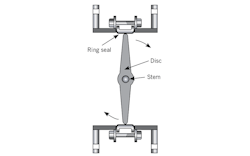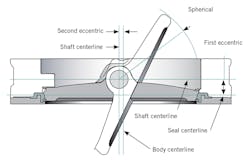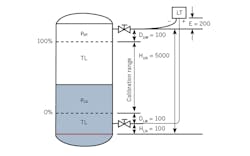Eccentric butterfly valves and errant dp cells
Q: Why is it that the shaft of some open/close actuators for rotary valves are off-center? Enclosed you can find an image of open/close butterfly valve (non-control valve) and its actuator. The shaft of the actuator is not in the center. Why? I think this is a rack-and-pinion actuator, and I couldn't find out why its shaft is out of center of the actuator.
Ali Rahimi
[email protected]
A1: When the size of a rotary valve (ball, plug) exceeds about 3-in., it tends to become bulky, hard to handle and—if manufactured of a sophisticated heat and/or corrosion-resistant material—can also become quite expensive. So, for larger valves, we consider using butterfly designs that can go up to 144 in. in diameter. Butterfly valve advantages include compact size, light weight, quick action, low pressure drop, high pressure recovery and tight closure. Disadvantages include poor throttling performance at high pressure drop, disc movement that's influenced by turbulence, and a potential for choked flow and cavitation. The disc of this valve can be concentric (Figure 1) or use an eccentric, cammed design (Figure 2).
This column is moderated by Béla Lipták, automation and safety consultant and editor of the Instrument and Automation Engineers' Handbook (IAEH). If you have an automation-related question for this column, write to [email protected].
You, Ali, are referring to the second version, which is also referred to as a high-performance butterfly valve (HPBV). The HPBV design has a cammed disc and a separable seat ring clamped into the body. It has two offsets: one is a shift in the position of the shaft behind the valve disk, and the second is a shift in the shaft position slightly to one side of the centerline. Due to this offset, the disk moves as a cam, which limits contact of the disk with the seat, and the spindle offsets the center of the seal face to form the first eccentric. The spindle offsets the disc from the center line of the pipeline to form the second eccentric. The combination of the two eccentrics generates the cam effect as the disc moves in or out of the seat, making it possible to separate the disc from the seat without requiring much torque.
The improvement in seal performance is because the disc cams in and out of the seat, and thus contact is made only at closure. There's almost no friction between the disc and seat as the disc moves from the open to the closed position. The resulting lowering of the required torque increases valve life, and allows it to be used under high pressure or various other working conditions.
Figure 2: The high performance butterfly valve (HPBV) design has an eccentric shaft and cam action disc that reduce its actuator torque requirements relative to a standard butterfly design as shown in Figure 1.
The actuator has to be big enough to overcome the sum of the hydraulic torque, the packing and bearing frictions, plus the force required to seat and unseat the disc into the liner. Nearly half of the cost of the valve assembly is the cost of the actuator, so the reduction in the hydrodynamic torque results in a smaller actuator and therefore lower cost.
In the case of both the lined concentric and eccentric designs, the Teflon or elastomer lining materials have to be carefully selected because of the potential for swelling, softening or cracking. These seat designs are usually classified as bubble-tight (ANSI Class VI).
Béla Lipták
[email protected]
A2: I believe that on closer inspection you’ll see that the shaft is designed to turn easily for much of its stroke, then pushes the disk into the seat just as it turns into closure.
Cullen Langford
[email protected]
Q: On gas service, I have a conventional differential pressure (dp) transmitter installed above the upper nozzle of the tank, so that condensate can be drained back into the vessel (Figure 3). My questions are as follows:
- Can we put the level transmitter above the upper nozzle, when we're interested in measuring the accumulated condensate liquid level in the tank?
- Please help me to derive the equation of LRV and URV to be set when conventional dp transmitter is kept above the upper nozzle.
- I've seen majority of level transmitters installed at the lower nozzle or below for head measurement. So, for this arrangement, what is impact on calibration range when the transmitter is installed above the upper nozzle?
- Is this arrangement—without the need for seal pot/purging or diaphragm-seal transmitters—allowed per international standards such as API best practices?
Jatin Katrodiya
[email protected]
Figure 3: Our experts urged Jatin to abandon the proposed configuration shown in favor of remote seals or purging.
A1: The proposed configuration makes little sense. If gas can be injected, use purging. If isolation is not required, use chemical seals and otherwise use wet leg with inverse transmitter. For details on all three approaches refer to my handbook.
Béla Lipták
[email protected]
A2: The operating pressure creates serious problems. It's my experience that everything leaks, the only question is how much? It would be very difficult to keep the high-pressure sensing line filled only with gas.
Your scheme as shown will most likely fail to work even at startup. If the pressure is low enough, then I would suggest using a purge on both connections. That will require a compressed gas source.
I would prefer to use remote chemical seals in this service.
Cullen Langford
[email protected]
A3: You certainly have a non-conforming installation. Most installations locate the level transmitter below the tank, and use diaphragm seals on both legs. Unless the “high pressure” leg is a filled tube with diaphragm seals on both sides, I don’t see how the high pressure from liquid level + vapor pressure can get to the transmitter.
If your high-pressure leg is diaphragm sealed and filled with an inert transfer fluid, it will appear to the transmitter as the head (pressure) of the transfer fluid + the head of the liquid in the tank + the pressure head of the vapor space. The low-pressure (LP) side will see only the pressure of the vapor space. When you subtract the HP pressure from the LP (the reading of the LT), you'll have the liquid level in the tank + the head of the HP leg. Since the HP leg is a constant, it can be removed by setting the zero point of the LT. Now you should be able to do your math.
Richard H. Caro
CEO, CMC Associates
ISA Life Fellow
[email protected] (buy my books at the ISA Bookstore)



